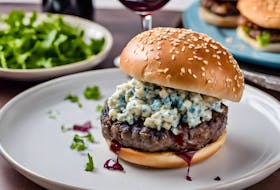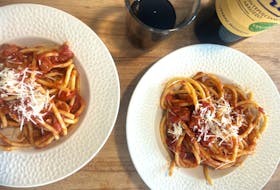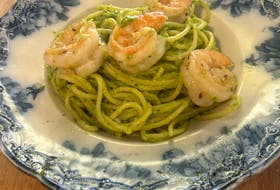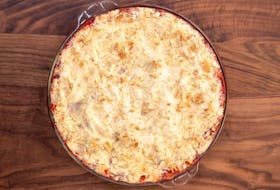I think there is a primal quality to the art of preserving food. Born out of necessity, smoking, pickling, packing in olive oil and using salt to cure fish, meat and vegetables alike all harkens back to times, pre-refrigeration and significantly earlier, when life necessitated preservation.
As we return to a deeper connection to our food stuffs, there has been a marked return to the art of preservation. I can think of no better guide in Atlantic Canada than Frederic Tandy, the Limoges (France) born and raised owner of Ratinaud French Cuisine on Gottingen Street in Halifax, N.S.
Tandy landed at Cape Breton’s Keltic Lodge in 2002 and has never left. Led by Tandy, Nova Scotia’s culinary scene has fully embraced charcuterie (the French art of preparing meat products such as pâté, terrines and cured meats). Just about every restaurant, from bistro to fine dining, boasts a charcuterie board.
While the process of curing the meat takes weeks, dressing up the board with elevated side dishes can be quick and easy. This week, In a Jiffy Frederic Tandy demonstrates how to make duck prosciutto and Mark DeWolf makes quick pickled vegetables to serve with it.
Ratinaud’s Duck Prosciutto
Recipe by Frederic Tandy, owner Ratinaud French Cuisine, Gottingen St. Halifax
2 duck breasts*, fat trimmed
750 g coarse sea salt
4 sprig rosemary, leaves removed
6-8 sprigs thyme, leaves removed
Directions:
Trim the duck breast to remove excess fat around the edges. Be sure not to over trim. Place the salt in a shallow dish and mix with the rosemary and thyme. Cover the duck in the salt, being sure to get all sides well covered. Lay the duck on the bed of salt and refrigerate covered for two to three days. Remove the duck breasts and rinse off with cold water. The purpose is simply to remove the excess salt; do not over rinse the duck. Dry with paper towel. Hang duck breasts in an old wine fridge that has been thoroughly cleans and disinfected to ensure no outside bacteria is present, set to 60 to 85 per cent humidity and 40 to 60 F. Let hang for three weeks. Check the duck daily to ensure no bad bacteria or mold has developed. **
*The duck breast needs to be thick as a smaller breast could taste to salty after the curing and drying process.
**Check out our video above for Frederic Tandy’s recommendations for how to deal with unwanted mold.
Editor’s Tip: Serve the duck prosciutto thinly sliced on a cutting board with toasted baguette, Oktoberfest Mustard and a variety of pickled vegetables. Alternatively, use the pickled vegetables and duck prosciutto to make a delicious seasonal salad. Simply toss your favourite local greens in olive oil, lemon juice, salt and pepper and add to a plate. Add pickled vegetables and top with slices of duck prosciutto.
Fred’s Tips: Curing meat isn’t for everyone. While there is an art to cured meat products, the science cannot be overlooked. Check out our In a Jiffy video to discover Tandy’s tips for curing meat including the conditions you will need to ensure dangerous molds don’t develop. Once you’ve made or purchased your duck prosciutto, according to Tandy you have weeks - even a couple months - to enjoy it. Be sure to keep it in a cool, dry well-ventilated space or your refrigerator.
Pickles on the Side
Recipes by Mark DeWolf

Indian-Inspired Pickled Cauliflower
1/2 head cauliflower, florets removed
1 tsp red chili flakes
1 tbsp turmeric
1/2 tbsp mustard seeds
3 garlic, sliced
2 cups apple cider vinegar
3 tbsp sugar
1/2 tbsp salt
Directions: Place cauliflower, chili flakes, turmeric, mustard seeds, ginger and garlic in a large sterilized jar. Place apple cider vinegar, sugar and salt in a pot. Heat until sugar and salt dissolves. Pour hot vinegar over the cauliflower. Close lid. Let pickled for four to five hours before serving. Refrigerate for up to three weeks.
Quick Pickled Carrots
1 small bunch carrots*, ends removed, scrubbed, quartered lengthwise
4 sprigs dill
4 cloves garlic, peeled
1 1/2 cups apple cider vinegar
1 ½ tbsp sugar
3/4 tbsp salt
Directions: Divide carrots amongst two small mason jars. Add two sprigs dill and two cloves garlic to each jar. Place cider, sugar and salt in a pot. Heat until sugar and salt dissolves. Pour hot vinegar evenly over carrots. Close lid. Let pickled overnight before serving. Refrigerate for up to three weeks.
Quick Pickled Red Onion
1/2 large red onion, peeled thinly sliced
1 cup red wine vinegar
1 tbsp sugar
1/2 tbsp salt
Directions: Place the onion slices in a small sterilized jar. Place the red wine vinegar, sugar and salt in pot. Heat until sugar and salt dissolves. Pour hot vinegar over onions. Close lid. Let pickle for two to three hours before serving. Refrigerate for up to three weeks.
Quick Pickled Radishes
1/2 cup radish, thinly sliced
1 cup red wine vinegar
1 tbsp sugar
1/2 tbsp salt
Directions: Place the radish slices in a small sterilized jar. Place the red wine vinegar, sugar and salt in pot. Heat until sugar and salt dissolves. Pour hot vinegar over onions. Close lid. Let pickle for two to three hours before serving. Refrigerate for up to three weeks.
Oktoberfest Mustard
1/2 cup mustard seeds
1/2 cup Oktoberfest lager
1/4 apple cider
1 tbsp brown sugar
1 clove garlic, minced
1/2 tsp salt
Directions: Marinate mustard seeds with lager overnight. Place mustard seed mixture, cider, sugar, garlic and salt in a food processor. Blend until smooth.
Mark DeWolf is a connoisseur of all things food and drink. He's a creative director with SaltWire and local fare is his specialty. You can subscribe to his Follow a Foodie newsletter here.









